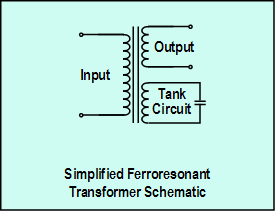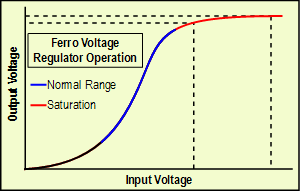Constant Voltage Transformer Operation
 The CVT (ferro) uses the unique principle of ferroresonance: operation of a transformer in the region of magnetic saturation. When the iron core of a transformer is in saturation, relatively large changes in winding current results in very small changes in magnetic flux. Winding current and magnetic flux are proportional to the input and output voltage, respectively. This means that relatively large changes in input voltage result in small changes in output voltage: this being the fundamental purpose of an automatic voltage regulator.
The CVT (ferro) uses the unique principle of ferroresonance: operation of a transformer in the region of magnetic saturation. When the iron core of a transformer is in saturation, relatively large changes in winding current results in very small changes in magnetic flux. Winding current and magnetic flux are proportional to the input and output voltage, respectively. This means that relatively large changes in input voltage result in small changes in output voltage: this being the fundamental purpose of an automatic voltage regulator.
 The graphic to the right shows a simplified version of a magnetization curve to demonstrate this concept. In the saturation region of the curve (red), a large change in input voltage results in a small change in output voltage. Operation in the saturation region has the disadvantage of very poor electrical efficiency. Standard power transformers are designed to operate in the normal range (blue) where electrical efficiency is higher.
The graphic to the right shows a simplified version of a magnetization curve to demonstrate this concept. In the saturation region of the curve (red), a large change in input voltage results in a small change in output voltage. Operation in the saturation region has the disadvantage of very poor electrical efficiency. Standard power transformers are designed to operate in the normal range (blue) where electrical efficiency is higher.
While standard power transformers have some minimal capacity for voltage regulation, their primary purpose is to transform voltage from one level to another (e.g. convert 480V to 208V) with higher electrical efficiency.

